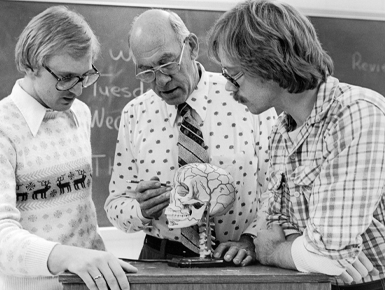USD Medical School: 50 Years of Forging Home-Grown Physicians

Since 1907, the USD medical school has provided high-quality medical education and served as the state’s only school of medicine.
During its first 67 years, the medical school provided instruction in the basic sciences and granted two-year degrees, necessitating that students transfer to other states’ medical schools to finish a four-year M.D. degree. Most of those who left didn’t return to South Dakota.
A Physician Shortage
Compounding the loss of graduates was an existing physician shortage in the state and the retirements of many family physicians. All this was taking a toll, as South Dakota ranked nearly last in the country for physician-to-patient ratio.
Something had to be done.

When Ted Muenster began working as chief of staff to Gov. Richard Kneip in 1970, the creation of a four-year medical school was not a front-burner issue, although it became increasingly important over the next couple of years. As USD and the South Dakota Board of Regents approached Kneip with the concept of a four-year medical school, the idea began to gain traction. Muenster remembers the time rife with excitement, but also challenges.
“South Dakota had very few specialists, as specializations were just emerging at that time,” said Muenster. “Most physicians were focused on family medicine. To have fully trained physicians, students needed to have exposure to all human ailments, and we didn’t know if we had enough examples in the state.”
Additionally, a full medical school was intimidating, and many worried its creation could bankrupt the state. Some argued that South Dakota didn’t have the necessary infrastructure. And would the school be able to produce the kind of handson experiences needed? “These were all legitimate concerns,” said Muenster.
But Wegner was relentless in his pursuit of support, tirelessly speaking, campaigning and knocking on doors across South Dakota. He went as far as to put a lien on his personal vehicle to fund his travel, according to one of Wegner’s colleagues. Even Wegner’s three children advanced the efforts, distributing bumper stickers and pamphlets that boldly proclaimed, “S. Dak. Needs a 4 Year Med School” and “Where does it hurt? Everywhere!”
Persistence Pays Off
Wollman and Wegner continued to rally the state of South Dakota to garner the history-making vote in favor of the transition, and it happened with a unanimous Senate and an overwhelmingly affirmative House voice. The USD School of Medicine officially became the four-year, M.D. degree-granting institution known today in February 1974.
Muenster asserted that the decision turned in the medical school’s favor because of Wegner’s personal credibility. “He listened, spoke softly, asked questions,” Muenster said. “It all boiled down to him when the legislature made the final critical vote.”
The bulk of the implementation details of the new curriculum were then left in the capable hands of USD President Richard Bowen (1968-1976) and his administration. With the help of Joe Massa, an assistant and 1963 USD business school graduate, Bowen and Wegner recruited physician specialists from around the country to South Dakota, many of whom joined the endeavor so they could teach while keeping a private practice.
And so, the “new” medical school began its four-year curriculum in 1975, with 39 students entering their third year of training.
That charter class of South Dakota-trained physicians walked across the Slagle Hall commencement stage on May 14, 1977. Kneip, as keynote speaker, told the group, “Today we have turned a corner in the fight for health care in South Dakota. South Dakota intends to win the fight for improved health care … but we have a long road before us, and we must not be impatient for results.”
Wegner then addressed the class, saying, “In this state where a shortage of doctors has cast a cloud over health care, May 14 signals the real possibility of more doctors for South Dakota.
“You may forget the date May 14, 1977, a few years from now,” he continued. “You may also forget there was a doctor shortage.”
Given the health care landscape in South Dakota today, it’s unimaginable that the medical school triumph of the 1970s would ever be forgotten.
Steadfast Presence
In a half century, USD’s medical school has conferred thousands of medical degrees and reached every corner of South Dakota through health care, research and education, speaking to its vital role in the state, something Wegner understood so profoundly all those years ago.
“We are extremely proud of the medical school’s accomplishments from the past 50 years, but we are also incredibly grateful to our past leaders who had the vision and perseverance to make this school as impactful as it is today,” said Dr. Tim Ridgway, the 15th dean of the USD medical school. “We would not be able to effect change in health care as we do today without the leadership and innovation of those individuals decades ago.”
Leaving a Legacy
In five decades since becoming an M.D. degree-granting institution, USD’s medical school has achieved prestigious honors and made significant impacts.
- Recipient of the Shining Star of Educational Innovation award from the Association of American Medical Colleges (AAMC) for the Longitudinal Integrated Curriculum (LIC)
- Recipient of the AAMC’s Spencer Foreman Award for Outstanding Community Service, considered the highest award a medical school can attain
- Ranks in the 100th percentile of graduates who practice in rural settings
- Sponsors, or is affiliated with, nine residency and four fellowship programs
- Created the innovative FARM (Frontier And Rural Medicine) program that places 13 medical students in eight rural South Dakota communities, producing 65 physicians to date
- More than 75% of its graduates who complete residency in South Dakota stay in South Dakota to practice medicine, compared to 18% prior to the creation of a four-year school
- More than 2,000 practicing physicians in South Dakota teach Sanford School of Medicine students each year



